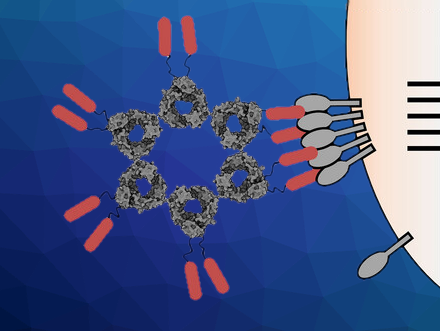Tumor necrosis factor receptors (TNFRs) are involved in cell signaling pathways and can be promising targets for cancer therapy. Examples of this type of target are the tumor necrosis factor receptor superfamily member 4 (TNFRSF4, or OX40) and TNFRSF10B (or death receptor 5—DR5, for short). However, TNFRs need to be cross-linked to trigger effective activation. For example, a multimerized OX40 ligand (OX40L), but not its monomer, can induce the aggregation of OX40, resulting in activation. Multivalent nanoparticles could be useful for multimerizing ligands or antibodies to induce TNFR cross-linking.
Cong-Fei Xu, Jun Wang, South China University of Technology, Guangzhou, China, and colleagues have developed a series of multivalent nanoscale TNFR agonists. The team fused ligands targeting TNFRs, such as OX40L or the tumor necrosis factor-related apoptosis-inducing ligand (TRAIL), which targets DR5, to a multivalent protein scaffold. They prepared a multivalent OX40L that targets OX40 and promotes T-cell activation by adding the ligand to the N-terminal of the protein scaffold. Similarly, the team created a multivalent TRAIL drug to induce tumor cell apoptosis.
The researchers also developed a kind of universal “nano-adaptor” by fusing a receptor that can immobilize antibodies to the protein scaffold. The resulting system can bind and multimerize antibodies, and thus, allows the rapid preparation of different TNFR agonists. Overall, the developed multivalent agonists can promote T-cell activation or directly induce tumor cell apoptosis, and the work provides a useful strategy for the development of multivalent protein drugs.
- Engineering nano‐clustered multivalent agonists to cross‐link TNF receptors for cancer therapy,
Yue Zhang, Gui Zhao, Yi‐Fang Chen, Shi‐Kun Zhou, Yue Wang, Yi‐Qun Sun, Song Shen, Cong‐Fei Xu, Jun Wang,
Aggregate 2023.
https://doi.org/10.1002/agt2.393




